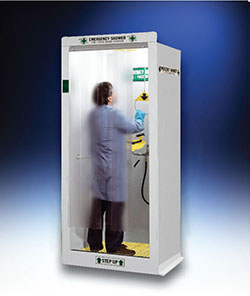1) Don't lick the drain! Also, most floor cleaners should kill most bacteria, so mop every once in a while. There are also bactracides that can be poured
dour the drain periodically.
2) I bet the architect would think it is worth the cost if they had to mop, squeeze mop so water goes into bucket, lift very heavy bucket and pour water
into sink, repeat, repeat, repeat…. How many gallons of water are dumped by safety showers per minute, again?????
The drain will not take all the water as it comes out, but it sure helps to have a drain to push the water to when you're cleaning up.
Don't let them talk you out of drains. Also, make sure the floor slopes in the correct direction.
Kay
From: ACS Division of Chemical Health and Safety [mailto:DCHAS-L**At_Symbol_Here**PRINCETON.EDU]
On Behalf Of Melissa Anderson
Sent: Wednesday, October 03, 2018 11:56 AM
To: DCHAS-L**At_Symbol_Here**PRINCETON.EDU
Subject: [DCHAS-L] Thoughts on some arguments against drains under safety showers
Hi Everyone,
This is a topic that's been discussed in depth before, but the architects planning our new science building had two arguments against drains under safety showers that I wasn't that familiar with and wanted to get people's thoughts:
1) Some medical facilities are calling them a health hazard due to possible build-up of biological stuff (presumably bacteria or mold?)
2) The drain will be too small to capture enough water to make it worth the cost (they did accept that a sloped floor might help with this)
--- For more information about the DCHAS-L e-mail list, contact the Divisional membership chair at
membership**At_Symbol_Here**dchas.org Follow us on Twitter **At_Symbol_Here**acsdchas
--- For more information about the DCHAS-L e-mail list, contact the Divisional membership chair at

